Apple iPad mini with Retina Display: Reviewed
by Anand Lal Shimpi on November 16, 2013 8:00 AM ESTThe SoC
The iPad mini with Retina Display rounds out the three platforms that use Apple’s A7 SoC. Although both the iPad Air and iPhone 5S use the A7, the mini’s implementation is closer in nature to the iPhone. The iPad mini’s SoC has always used the same package-on-package (PoP) assembly as the iPhone, with DRAM stacked on top of the SoC itself (1GB in this case). The benefit is obviously a reduction in board area, the downsides have to do with cost and thermals. That’s the first similarity between the mini’s A7 and the iPhone’s A7.
The second is one of frequencies. While the iPad Air’s A7 runs its two Cyclone CPU cores at up to 1.4GHz, the SoC in the iPad mini and the iPhone 5S runs at up to 1.3GHz. That might sound like a minor difference, but it’s far more pronounced when you look at what happens to frequency when you’re running heavy workloads.
Once again I turn to a fairly heavy CPU workload to plot performance over time. This is a multithreaded workload, slightly modified from what we used in the iPad Air review, designed to make the CPU cores consume max power. The scale is linear and the workload is the same across all devices, so what you’re effectively looking at is a graph of thermally bound CPU performance over time across all three A7 implementations:
Being the largest device (and the only device with a metal heat spreader and no DRAM stacked on top), the iPad Air obviously maintains the highest frequencies for the duration of the test. The iPhone 5S, with a significant reduction in internal volume (and a PoP SoC) reduces its CPU frequencies early on in order to keep skin temperature down and properly manage thermals. The iPad mini with Retina Display falls between the two, with its performance curve more closely following that of the iPhone 5S.
Although the mini has a similar max operating frequency to the iPhone 5S, it is a faster device thanks to it being less thermally constrained. Similarly, the iPad Air can be much faster than its clock speed would otherwise imply. If you’re wondering why Apple has been so focused on building its own SoCs and CPU architectures, this is the reason why. There’s a fixed amount of power you can dissipate in the form of heat in these mobile devices while still maintaining a good user experience. Performance per watt is the gating metric for success in mobile, and shipping high IPC/low frequency dual-core SoCs at 32/28nm is the best optimization available to a company like Apple today.
As you’d expect, our browser based CPU tests show the mini’s A7 performing in between the iPhone 5S and iPad Air. None of these tests are anywhere near as stressful as our thermal test from above, so we don’t see exaggerated differences in performance between the platforms. For most, I suspect you won’t notice a huge performance difference between the mini and Air. Those who are heavier users (e.g. audio mixing, 3D gaming, etc…), there will be a performance difference between the two iPads.
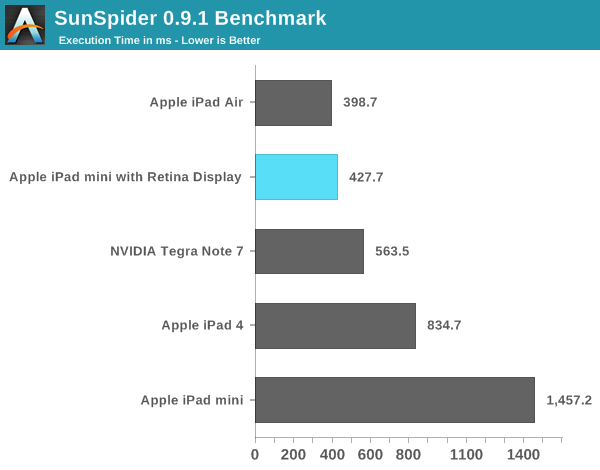

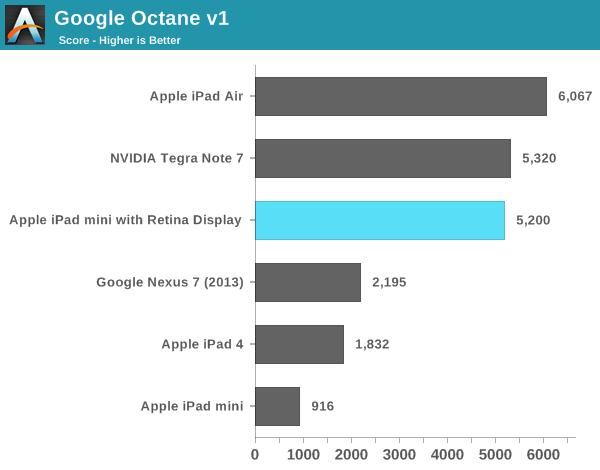
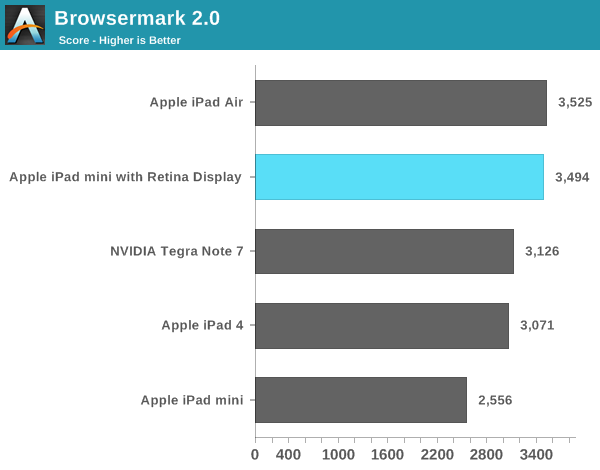
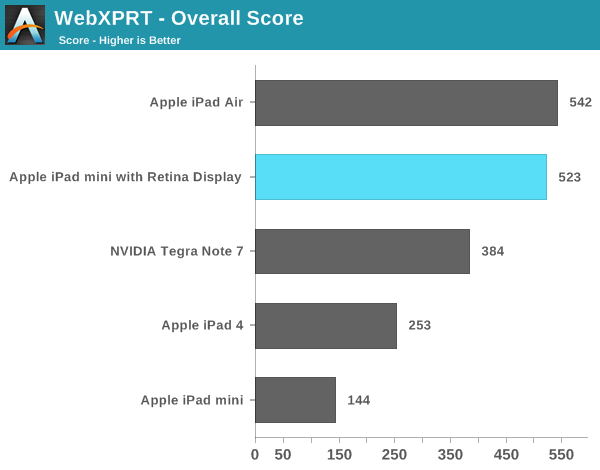
Compared to the first generation iPad mini, the new model is in a completely different performance league. Keep in mind the first mini used Apple’s A5 SoC based on an ARM Cortex A9. That’s the same single threaded performance as what’s in an iPhone 4S, and under iOS 7 it’s clearly running into some performance limits. The new mini with Retina Display however is a completely different animal. It’s fast.
Even comparing to the 4th generation iPad, the new mini is noticeably quicker.
Memory Bandwidth
Looking at the iPad mini’s memory bandwidth curve, we see it tracks very closely with that of the iPhone 5S. This is a slightly modified version of our previous bandwidth test, and you can see peak usable memory bandwidth (from the CPU’s perspective) of around 10GB/s. The ~12GB/s area right before you get out to main memory is bandwidth to the A7’s 4MB system-wide cache that sits after the shared L2 and the memory controller. This cache appears to service CPU, GPU and ISP requests at least.
GPU Performance
I believe the A7’s PowerVR G6430 GPU runs at around 450MHz. This frequency appears unchanged across all three A7 implementations. Once again, the big difference is how much thermal headroom exists in the platform which has an impact on overall performance.
Kishonti’s low level GPU performance tests back up my assertion that GPU frequency is fixed across all A7s. The iPad mini with Retina Display delivers equal performance to the iPad Air. The bigger news here is that nearly all of the GPU bound 3D tests seems to peg the mini and Air as equals. These are some pretty intense tests, but it looks like on the GPU side there’s no significant throttling when running at full tilt.
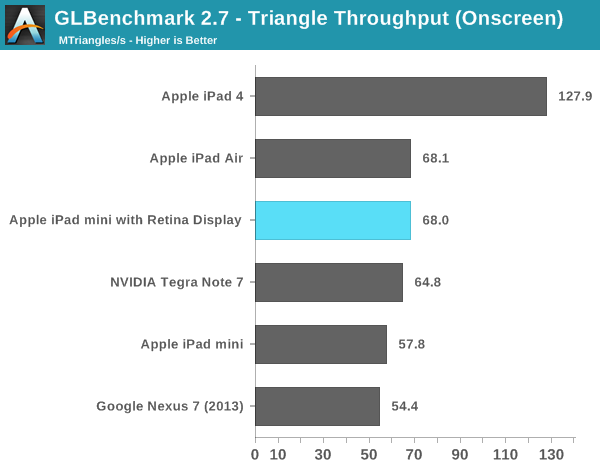

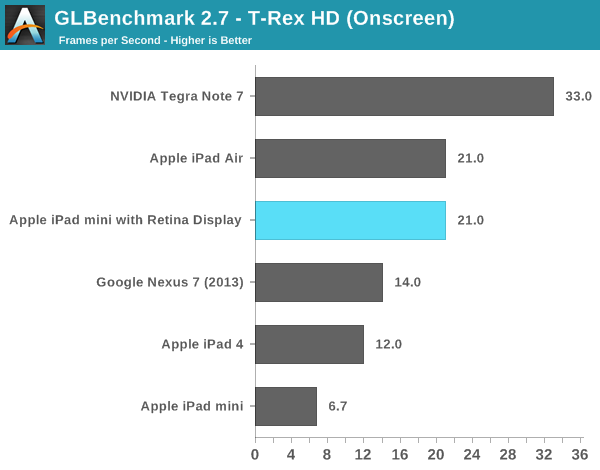

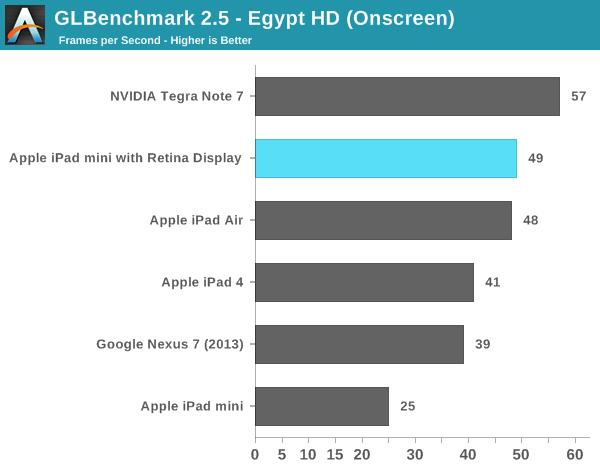
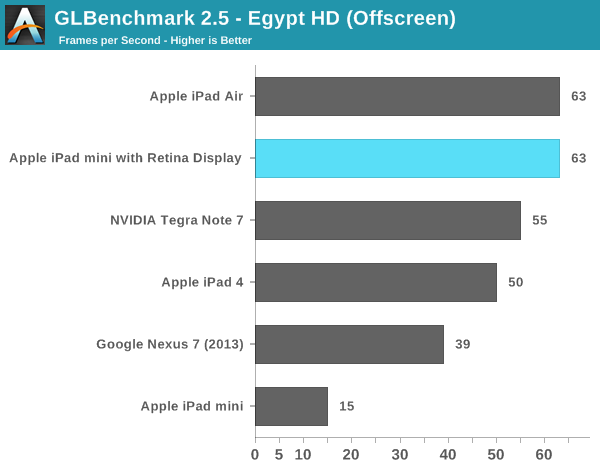
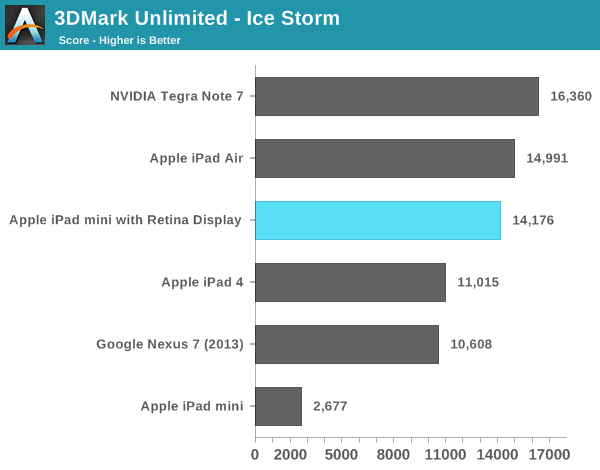
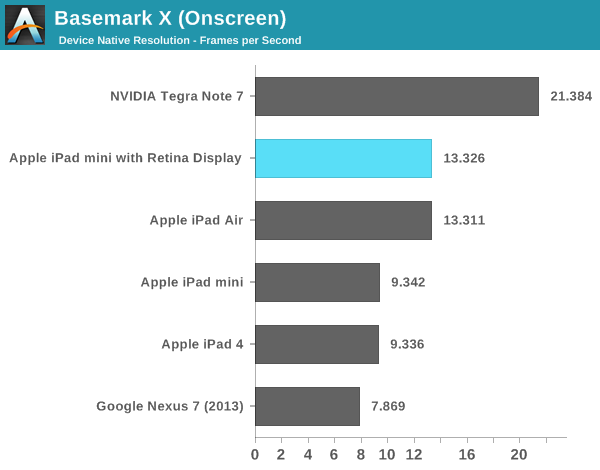
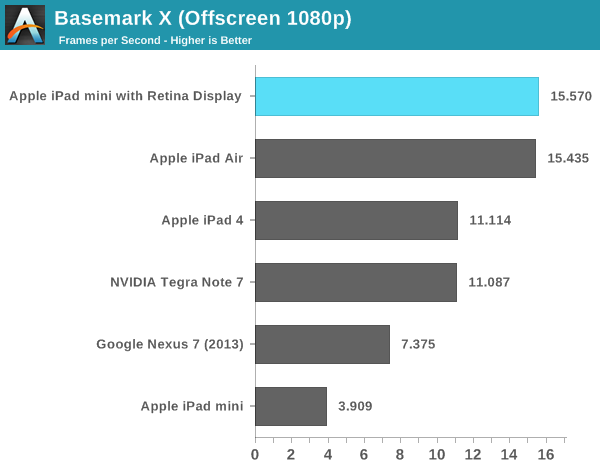
As I mentioned in our iPad Air review, despite having less peak theoretical memory bandwidth than the A5X/A6X, the A7 in the iPad mini never seems to regress in performance compared to even the iPad 4. Across the board the mini appears to be faster, more responsive and have more performance on tap than any prior iPad (big or small). The comparison to the original iPad mini is of course night and day. Even looking at lighter tests like the old GLBench Egypt HD benchmark, the iPad mini with Retina Display manages to be nearly twice as fast as the original mini - all while rendering 4x the number of pixels.


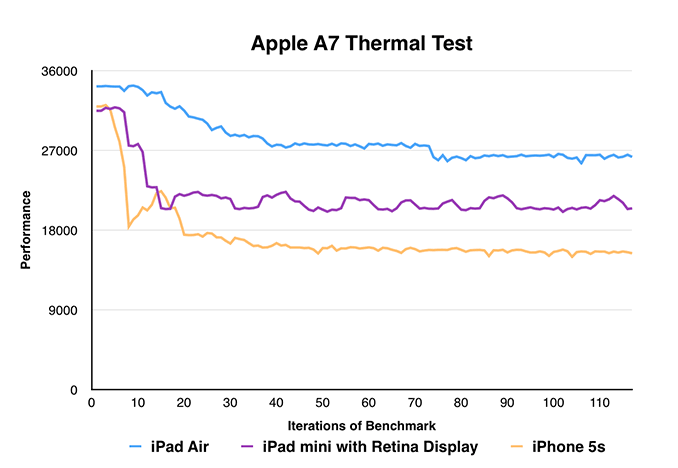
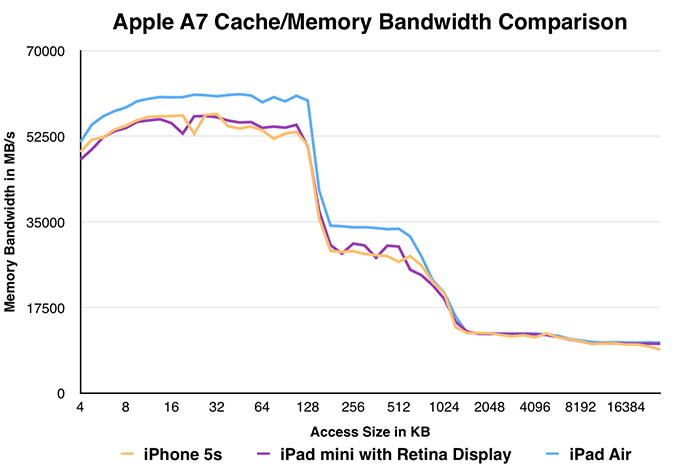








345 Comments
View All Comments
puggsly - Monday, November 18, 2013 - link
His point was much simpler than all of that. Things are worth what people will pay. If you can't build a product as fast as people are buying it, then you obviously didn't over price it. The problem with this is that if demand only out strips supply for a short time, maybe you did over price, which is possibly where the iPad Mini 2 will fall. People who really want the upgrade will justify the price but anyone on the fence may hold off. Most of this argument would be removed by killing off the 16GB version and shifting the line to 32GB @ $399 64GB @ $499 & 128GB @ $599 (maybe a 256?). This is a huge shift in value to the consumer for a trivial change in cost/margin to Apple and I believe would better maintain Apple's marketshare.ELPCU - Tuesday, November 19, 2013 - link
Ur argument has a point, and I sort of agree, but bis point is not that.he said, apple marin is not super high.
If he wants to say what u said, then he should not talk about "margin"
Freerange1 - Monday, November 18, 2013 - link
Go get yourself a good education! As you are clueless. All the other handset makers are losing money! Yet Apple's margins are too high? It should be obvious, even to a halfwit, that in fact the other manufacturers are too low! Duh! Even when adding more memory, there are more costs than just chips! You have engineering costs, manufacturing costs and assembly costs, packaging costs, labeling costs on the device itself, inventory and fulfillment costs, etc.Further, The other makers get the OS for free! While Apple's hardware margins also cover the cost of a much larger ecosystem, much better and more extensive customer support, IOS development, free software such as iWork, etc. Why do you idiots keep spouting off the same rediculous BS.? Back to school for you - you have failed!
ELPCU - Tuesday, November 19, 2013 - link
Nope, they just did not sell enough phones. Not all other handset makers are losing money. For example, Samsung makes a tons of money. Other top tier Android phone makers generally stays even or make some margin.I know non-top tier Android phone makers are losing money, and If we compare to Apple, there are not many company to even compare margin, because Apple makes ridiculus amount of margin, but that does not means other phone margin is too low.
I need to admit that OS development/investment is Apple's special investment with right direction, but Apple makes money out from OS due to App store. Yes, they gave you free software, but they have indirect way to make extra money for those investment.
Customer support is something Apple is doing decent. Especially in US, they are known as doing great job. But not throughout all the world. Especially for country without apple store, customer support of Apple is infamous for doing a terrible job. Also, Apple's policy is not flexible, which could be a problem for some customers.
For example, not all customers prefer exchanging to refurbish phone, but Apple's policy is usually just exchanging to refurb phone. In US, delivering back and forth takes at least usually more than 2 weeks, so most customers are happy about exchanging to refurb, but for example in Korea, delievering back and forth usually takes 2~3 days, so there are a lot of customers prefering just repairing their own phone.
akdj - Monday, November 25, 2013 - link
As an owner of Apple products for a couple of decades...and since the age of retail Apple stores, since the release of the original iPod I have NEVER, EVER seen a product replacement take 'at least usually more than two weeks back and forth'. NEVER. This is pure, utter Bull Pucky! Typically, if your item is under warranty, Apple will overnight a return box to you---and IF you have to ship it out (no Apple store in close vicinity), return times are EXTREMELY fast! Even full display and logic board replacements are sometimes as fast as 24 hour turn around times (once they've received it). Send it out Monday, sometimes...many times, you'll have it back by the end of the week.And whoever is taking BOM in to account as the ONLY pricing that goes in to each and every iPhone is forgetting the expense of R&D, machining, setting facilities, factories and employees as well as the Raw Materials necessary to build the new phone. Hence, and most likely the reason Apple typically gets two years out of each design package (see 's' models for iPhones, the iPad 3 and 4....even their computers tend to get 3-5 years out of their specific model). Fusion arc welding? Anodization of aluminum....they're definitely riding the cutting edge of plastics as well. The new FoxConn factory build out with machines/robots/computers for fabrication is going to cost well in to the billions this next year---in fact, wasn't it just released they've earmarked almost 10Billion for 2014 fabrication plants, re-tooling factories, training and R&D?
Apple DOES make money---they're smart about their manufacturing process, and they're the MOST successful selling specific makes and models....more than ANY other specific make or model from ANY other manufacturer. Yes...Samsung makes money, good money---about 20% of the overall 'profit' margin of the overall handset market. Apple? almost 75% of the OVERALL profit! That's amazing...especially with the build quality of each individual product, their ability to 'last', design, speed, eco-system, services continue to get better and better....post purchase support...Have you EVER tried to get a Samsung phone repaired? I have---the original Galaxy Note. Took almost 6.5 weeks to get it back, it was a refurb (not a repair) and I had a crappy 'loaner' phone from AT&T.
It's NOT Apple's fault they were so smart initially setting up their system with carriers (where the bulk of the money goes to Apple, not the carrier). No seller of the iPhone is making a profit, other OEMS are allowing subsidized profits to the carriers. Apple was absolutely Brilliant when it came to that negotiation....AND the reason AT&T was the only carrier in the US for a couple year, Verizon didn't want to take that 'no profit' from hardware challenge on...all the while missing those massive two year data contracts. THAT'S where the carrier money SHOULD be, in the service, NOT the hardware.
Would be cool if Android got more of a hand on this and helped Samsung slim down their TouchWiz BS (and bloat)....look at HTC's new Sense and it's lesser 'weight' on the UI. Check out the Google versions of the One or the S4. Much, Much smoother...and you can 'add' the launchers you want.
It's hilarious to read what a 'sin' it is for a company to make money. You SURE don't see people slamming Exxon everyday we're paying out our noses @ the pump!
Apple is smart, they're releasing exciting...fun products that are easy to use, yet powerful at the same time....they sport longevity, long battery life...more software available than at ANY other time in history for a single set of devices (iOS)----doesn't matter what you're into, 'There's an App for That!'----then, two, three years down the road when you want a new iPhone, or a new iPad, you can easily turn around and recoup 50-75% of the money you spent when you bought it new! That's amazing to me!!!! Try selling a two or three year old Windows laptop, a two year old Android plastic phone....or just look at 'completed' listings on eBay, that tells a whole 'nother side of the story! That money you HATE to give to Apple in the end, you get it right back in your pocket WITH another brand new, shiny, bad ass and FAST device of the latest iteration.
Win. Win.
ELPCU - Wednesday, November 27, 2013 - link
OK, Preeetty long reply both yours and mine, so let me break down.- I have not experienced sending Apple product, so I need to admit you probably right and I am wrong about returning service. But, my argument still stands. Apple service is generally good, and especially great in US, but it SUCKs in some countries such as South Korea which does not have apple store.
- BOM part : You clearly have not read some of my comment. I will copy-paste part of my comment for you. "Bill of material is not exact number used for calculating margin, because of warranty cost, marketing cost, licensing cost, etc, but if you uses 150% of BOM, which will give very close number of real unit price." The reason why I have mentioned BOM, because I do not have exact apple's unit price. Note I mentioned 150%, because iSuppli mentioned 1st gen Nexus 7 is about zero margin, and its BOM was 66.9% of MSRP. 66.9% is roughly 2/3, so it seems multiplying 3/2 is good enough calculation for me.
Again I know BOM is not exact number I want, but I am just roughly estimating, but all iphone BOM are around 200bucks, so 150% is 300 bucks. Considering unlocked iphone with lowest storage is 650 bucks, it still shows Apple makes more than 100% margin rate.
- "Apple DOES make money" : Let's face it. This is just not right way to describe Apple's margin. Right way to describe is "Apple make A TONS OF money". You said samsung make good money, which is about 20% of overall profit of whole smartphone market, and describing Apple which takes 75% of overall profit of WHOLE smartphone market as just "does make money". Stop being deceptive.
Is making money is a bad thing? Nope. I know All company's goal making money.
Is making a tons of money is a bad thing? This one is kinda Yes.
Making a tons of money itself is not necessarily a bad thing, but generally company has done something ridiculus for making a ton of money.
You have mentioned Exxon, which is a great example of this part. Success of current major oil companies including Exxon comes from old Standard Oil company. Of course, Standard Oil is infamous due to monopoly as you know. Antitreust law break Standard Oil into several pieces, and some of those major oil companies took over some fracture of Standard Oil companies or companies like Exxon and Mobil were those broken Standard Oil companies. Although Standard Oil had been punished, current major oil companies comes from those remnant of monopoly.
Taking over some remnant of monopoly company itself is okay, but they are having excessive amount of market control-using old remnant of monopoly-is something we do not want.
Yes, we do not talk too much about Exxon in everyday life, at least compared to Apple, but this is mainly Apple is rising star. People are just used to those oil company's control, so this is just less shiny issue. Also, nowadays there is a thing called OPEC, which is another big oil price controlling factor. So blaming only companies Exxon or Shell does not cover issue enough as well. However, no one like expensive oil price.
Back to Apple, Apple is not doing monopoly now, but they are doing some ridiculus thing for making the money. Most obvious one? Storage.
http://www.isuppli.com/Teardowns/News/Pages/Ground...
It shows BOM of iphone 5s, and if you look BOM difference btwn 16GB and 32GB, it is 9.4 dollar. 32GB -> 64GB? 10.2 dollar difference. Lets' rounds up, and say 10 bucks. Again, remember, 150% of BOM is break-even, so If Apple make us to pay 15 bucks for storage upgrade, then it is even. Note they are already making a lot of money elsewhere, too, so break-even is not super generous thing in this case. However, you are paying 100bucks for every storage.
As you know, this storage increase is nothing relavant to Apple's service quality or their investment for new fab. And, I am sure Apple do not need THAT much of money for developing nice and great new product or providing great service.
Even without those storage price increasing aka being a BS, Apple make a TONS of money, but they are still not satisfied, so makes more money by doing BS thing. Yet guy like you still cheer Apple so happliy.
Note monopoly was not illegal a long time ago. I mean more than 100 years ago. The reason why monopoly is bad, because they are forcing customer to buy product with ridiculus price. Apple is kinda doing similar thing. If we talk about a common laptop, I do not care much about storage, because I can swap HDD myself. If there was a SD card slot, I will not care too, because I will put microSD card. If Apple let other company to use their iOS(I know there will be a ton of tech issue such as optimizing issues or compatibility issue, but it is just one of if. Stop being nitpicking about my argument.), so I can have a light and decent iOS device, then I will not cry this much. But Apple is doing none of them, which force me to buy device with higher storage AND they set up ridiculus price. Doing fairly similar thing compared to monopoly. Forcing customer to buy item with ridiculus price
There should be no excuse for this BSing. this is not Win Win by any mean.
Another deceptive thing about having low storage is that review became deceptive.
All freaking review said iPad cost 499, but in reality, 16GB is just not enough for iPad user.
And review talks about Price/performance considering iPad cost just 499.
To me, it just sounds like iPad cost starts like 599. Not just because 16GB iPad user feels lack of storage but also because Apple is intentionally holding its storage. 16GB was first gen iPad's base storage. IT IS STILL SAME for 5th generation!!
Another thing is an expensive Apple accessory with their own standard cable.
Making their own cable is not necessarily terrible thing, but their accessory is ridiculusly expensive. and when 3rd party company starts to make a lot of accessory, they change their connector to new freaking lightning connector without any good reason! If there was at least decent performance increase, I might understand, but advantage of having lightning connector other than 'small and able to use for both direction' is almost non-existance.
There were terribly expensive iphone 30pin docking station in the market already.
If you were the one who had something like B&W Zeppelin(600 bucks) with 30 pin, you probably won't be too happy. Yes there is adapter, which make it work, but it still harm overall look, which is one of big pro apple pdt has. Also, adapter cost you 30 bucks. tiny little adapter cost 30 bucks? that is 5 bucks at most!
Again, price of storage and accessory are not relevant to any of those OS investment. If Apple wants to make money for investment, then fair way to doing it, is increasing their base price of iphone and iPad, but they won't do it, because they knew it will reduce their customer, so they are being ridiculus.
pmarreck - Monday, November 18, 2013 - link
If the market supports a 100% markup over the cost of parts... Then frankly that's just capitalism, and that margin is well-deserved. It's not like it doesn't have any competitors! But if you are a spec numbers whore, then you can go nuts and get your Android powered device for less, and miss out on the raw fact that the whole can be worth more than the sum of the parts. In fact, that is EXACTLY how "value" is created out of nothing!ELPCU - Tuesday, November 19, 2013 - link
I did not said 'apple's margin is NOT well-deserved.'Despite of ridiculus amount of margin, people still want it, and I have no problem with that fact.
I just bought iPad Mini Retina 128GB Wifi. I know it has ridiculus margin, but I found out it is still worth to buy it, because I have used my iPad 4th gen tremendously a lot within a year, and I am sick of its small storage so I bought it.
I just mention it his statement "Apple's margin is not super high" is totally wrong.
akdj - Thursday, December 19, 2013 - link
I absolutely did NOT say "Apple's margin isn't super high"...NO Where! My point, and your counter was they don't make 75% of the profits....guess what, they DO! While Samsung enjoys 80% share +/-, Apple is enjoying nearly that same take in profit. That is again, FACT. Not BS. I understand BOM. I also understand ANY Flagship Android device also costs in parity with the iPhone 5s. Note 3. S4. HTX One. LG G2. There are certainly other options...but flagships, unlocked....are ALL 750-850 Bucks. All margins are high on consumer electronics....especially as the company's experience and reliability, speed and 'know how' improve. That said, you're arbitrarily throwing costs around when you're not in the know when it comes to SoC bottom to top configuration and design (A7). 64 bit A8 instructions set, new XCode to help developers in OSx to conform their apps....the 'R&D' if you will, as this is the FIRST TIME this has been done by an OEM! Qualcomm is apparently shell shocked. As is Samsung....and THEY baked the cookies! Lol....advertising, investing and inventing....buying other companies, and another probably 2300 'things' that go in to price per phone @retail. Not. Just. B. O. M.Lord
darwinosx - Tuesday, November 19, 2013 - link
Your numbers are way wrong and you are apparently somehow unaware that top end Android phones and and tablets cost as much as Apple devices. You would also be more credible if your spelling and grammar weren't so poor.